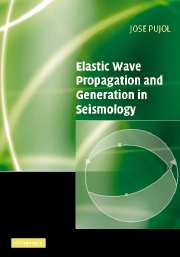Book contents
- Frontmatter
- Contents
- Preface
- Acknowledgements
- 1 Introduction to tensors and dyadics
- 2 Deformation. Strain and rotation tensors
- 3 The stress tensor
- 4 Linear elasticity – the elastic wave equation
- 5 Scalar and elastic waves in unbounded media
- 6 Plane waves in simple models with plane boundaries
- 7 Surface waves in simple models – dispersive waves
- 8 Ray theory
- 9 Seismic point sources in unbounded homogeneous media
- 10 The earthquake source in unbounded media
- 11 Anelastic attenuation
- Hints
- Appendices
- Bibliography
- Index
9 - Seismic point sources in unbounded homogeneous media
Published online by Cambridge University Press: 12 November 2009
- Frontmatter
- Contents
- Preface
- Acknowledgements
- 1 Introduction to tensors and dyadics
- 2 Deformation. Strain and rotation tensors
- 3 The stress tensor
- 4 Linear elasticity – the elastic wave equation
- 5 Scalar and elastic waves in unbounded media
- 6 Plane waves in simple models with plane boundaries
- 7 Surface waves in simple models – dispersive waves
- 8 Ray theory
- 9 Seismic point sources in unbounded homogeneous media
- 10 The earthquake source in unbounded media
- 11 Anelastic attenuation
- Hints
- Appendices
- Bibliography
- Index
Summary
Introduction
In the previous chapters we studied the propagation of plane waves without consideration of the source of the waves. Although this approach is very fruitful, it does not allow investigation of the waves generated by seismic sources, either natural or artificial. Earthquakes are the most important natural sources, and the study of the waves they generate has played a major role in our understanding of the inner structure of the Earth and the nature of the earthquake source, which will be the subject of the next chapter. However, before reaching the point where it can be analyzed it is necessary to start with simpler problems, which will be done in this chapter.
The simplest problem corresponds to a spatially concentrated force (or point source) directed along one of the coordinate axes. Even in this case, however, solving the elastic wave equation is a rather complicated task that requires considerable mathematical background, which is provided below. The starting point is the scalar wave equation with a source term, which is first solved for an impulsive source, in which case the solution is known as Green's function for the problem. Then the Helmholtz decomposition theorem, which we have already encountered in §5.6, is used to reduce the solution of the elastic wave equation to the solution of two simpler ones. After this series of steps, and considerable additional work, the problem of the concentrated force can be solved.
- Type
- Chapter
- Information
- Elastic Wave Propagation and Generation in Seismology , pp. 278 - 315Publisher: Cambridge University PressPrint publication year: 2003



